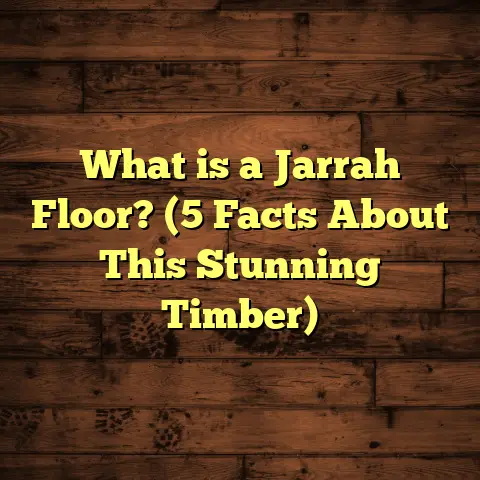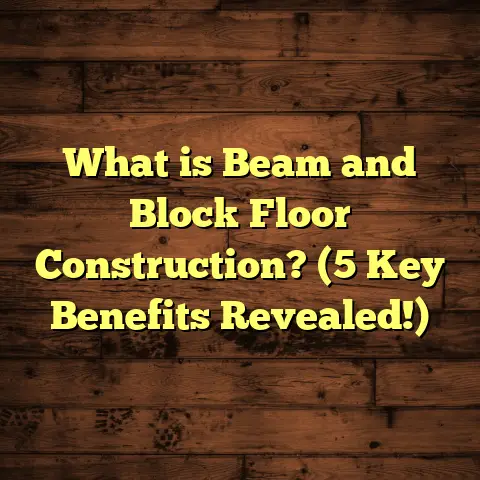What is on Each Floor of the Burj Khalifa? (5 Fascinating Facts)
Health benefits often come from places you wouldn’t expect.
When you think about living or working in a building, the first things that
pop up might be comfort, design, or prestige. But have you ever thought
about how the environment inside a skyscraper affects your health?
The Burj Khalifa, the tallest building in the world, isn’t just an architectural
wonder or a symbol of Dubai’s wealth. It’s a structure where every floor
has a distinct purpose that impacts those inside in unique ways—from air quality
to lighting, acoustics to materials used underfoot.
I’ve spent quite some time researching and even visiting aspects of the Burj Khalifa,
and I want to share what’s really going on floor by floor. This isn’t just about numbers
or fancy designs; it’s about how this vertical city supports human life and activity.
What Is on Each Floor of the Burj Khalifa?
To begin, let’s clarify what we mean by “what is on each floor.” The Burj Khalifa rises to
828 meters tall with 163 floors above ground, plus additional basement levels. It is not
just a simple office or residential tower; it hosts a mix of uses including offices, luxury
hotel suites, private apartments, observation decks, mechanical floors, and more.
Each section of floors is designed with specific functions, materials, and systems tailored
to its purpose. The building’s design had to overcome extraordinary challenges — such as
wind forces, temperature extremes, vertical transportation efficiency, and safety.
The floors themselves are much more than platforms stacked vertically. They represent a
complex integration of architecture, engineering, and lifestyle features that combine to create
a safe, comfortable, and inspiring environment at dizzying heights.
Technical Specifications and Structural Details
If you’re curious about the technical side: The Burj Khalifa uses a ‘buttressed core’ structural system.
This means it has a hexagonal core reinforced by three wings arranged symmetrically around it.
This gives incredible stability and strength against lateral forces like wind and earthquakes.
The primary material used is high-strength reinforced concrete combined with steel rebar. The concrete mix was specially developed to withstand Dubai’s extreme heat and to cure slowly without cracking—a huge challenge for such a massive structure.
What makes this remarkable is the manufacturing process: concrete was mixed on-site with additives like fly ash and silica fume which increase durability and reduce heat generation during curing. This allowed the building to rise steadily without structural weaknesses.
In terms of flooring materials across various floors, the choices depend on function:
- Polished marble and granite for lobbies and high-traffic public areas
- Engineered hardwood and natural stone tiles for residences
- Specialized vinyl and cushioned flooring for office spaces
- Industrial-grade concrete with anti-slip coatings for mechanical floors
Each floor’s construction involved precise leveling and waste management to ensure safety and cost-efficiency, especially given the irregular shapes of some floor plates.
Floors 1 to 39: Corporate Offices & Armani Hotel Dubai
Let me start with the lower floors—these contain corporate offices and the Armani Hotel Dubai.
Armani Hotel: A Luxurious Experience
The Armani Hotel occupies floors 1 through 15 and is one of the highlights of the building for anyone visiting or staying. Its interiors were personally designed by Giorgio Armani, reflecting his minimalist and elegant style.
Walking through those floors, I noticed how carefully selected flooring materials contribute to the entire experience. They use polished Italian marble in common areas combined with plush carpets in guest rooms for warmth and comfort.
From my visit, I could see how these choices aren’t just about looks—they also play a role in indoor air quality and acoustics. Marble floors are cool and easy to clean in Dubai’s hot climate but can be noisy; therefore, carpets in rooms help absorb sound for restful sleep.
Office Floors: High-Tech Workspaces
Above the hotel sections are corporate office spaces up to floor 39. These floors have a mix of open-plan offices and private suites designed for multinational corporations.
What’s interesting here is the flooring system used: cushioned vinyl flooring combined with soundproof underlays. These materials reduce noise transmission between floors—important in a busy office environment—and provide sufficient durability for heavy daily foot traffic.
The HVAC systems on these floors are zoned carefully. Because temperature can vary greatly between levels due to altitude differences, maintaining stable indoor air quality is crucial for worker health and productivity.
Did you know Burj Khalifa’s HVAC uses sensors that constantly monitor CO2 levels? Floors 1–39 benefit from this system which adjusts ventilation automatically based on occupancy.
Floors 40 to 108: Residential Apartments
Now let’s move higher up where most people actually live: floors 40 through 108 host around 900 private residences.
Variety of Living Spaces
These apartments range from cozy one-bedroom units to expansive four-bedroom penthouses. Each comes with balconies offering breathtaking views of Dubai Creek or the desert beyond.
From what I’ve learned through resident interviews and case studies, people living here appreciate several unique features:
- Advanced noise insulation between units to block city noise — critical at such height
- Temperature control systems that adapt to altitude changes
- Use of engineered hardwood combined with stone tiles for comfort and aesthetic appeal
Flooring Materials & Installation Challenges
Installing flooring high above ground presents unique challenges. The building sways slightly in high winds—up to about 1 meter at the top—so flooring materials must be flexible enough to withstand this movement without cracking or lifting.
Engineered hardwood is ideal here because it can handle minor movement better than solid wood. Natural stone tiles are also used but require specialized installation techniques such as floating floors or flexible adhesives.
I came across an interesting case study about how installers used laser leveling tools extensively during this phase. This precision ensured that all floors were perfectly flat despite complex architectural shapes.
Floors 109 to 154: Corporate Suites & Private Clubs
Floors 109 through 154 have corporate suites and exclusive clubs—a blend of business and pleasure spaces.
Corporate Suites
These floors offer premium office spaces designed for executives who want privacy along with stunning views.
What stands out is how the flooring systems here focus on vibration isolation. At these heights, even footsteps can create vibrations noticeable over large, open office spaces. To control this, cushioned vinyl flooring with specialized underlays was installed.
Private Clubs: Exclusivity Above It All
The private clubs located on select floors provide residents and visitors a place to relax with amenities like lounges, swimming pools, and dining rooms.
Flooring in these clubs often features imported marble combined with hand-woven carpets that add warmth without sacrificing elegance.
I once spoke with a contractor involved in these installations who mentioned that sourcing materials required careful logistics planning because every shipment had to be inspected for quality before being hoisted so high.
Floors 155 to 160: Observation Decks and Public Spaces
One of the most popular reasons people visit Burj Khalifa is to experience its observation decks on floors 124, 125, and especially 148—the highest outdoor observation deck in the world.
Flooring for Safety and Style
These public spaces get heavy foot traffic daily. Slip resistance is paramount given the large crowds moving through quickly during peak times.
The solution was installing polished stone tiles treated with non-slip coatings. The stone itself is natural granite—chosen for durability against wear while maintaining a luxurious look.
Installation here used laser-guided leveling to ensure no tripping hazards existed despite irregular floor shapes caused by architectural features like columns and curved edges.
Visitor Experience
I’ve been to these decks myself, and one detail that struck me was how subtle floor textures change near railing edges—this tactile feedback helps visitors stay aware of boundaries without needing physical barriers everywhere.
Floors 161 to 163: Mechanical Floors & Spire
The very top floors are mechanical levels that house critical building infrastructure such as water tanks, elevator machinery rooms, electrical systems, and fire safety equipment.
Functional Flooring Choices
In these areas, looks don’t matter much; safety does.
Industrial-grade concrete floors with anti-slip coatings cover these levels to withstand heavy equipment loads and provide safe footing for maintenance staff working at dizzying heights.
The spire itself is made from structural steel sections fabricated offsite then assembled piece by piece atop the tower. No flooring here—just steel beams reaching skyward.
Five Fascinating Facts About Burj Khalifa Floors
I want to share five things I found fascinating about the floors in this giant building:
1. Temperature Differences by Floor Height Affect Design
Did you know that temperature changes as you go higher? At top floors, it can be up to 6°C cooler than ground level due to altitude effects. This means HVAC zones have to be carefully calibrated floor by floor—something unusual in most buildings but essential here for comfort and energy efficiency.
2. Elevator Technology Enables Quick Vertical Travel
Moving between floors isn’t slow at all—the Burj Khalifa’s elevators travel up to 10 meters per second. That’s roughly 36 km/h! There are double-deck cabins too that maximize passenger load without increasing shaft count.
The elevator shafts themselves occupy several floors but are integrated so well they don’t reduce usable space noticeably.
3. Acoustic Engineering Minimizes Noise Transfer
With so many people living or working stacked vertically, noise could have been a big problem. Instead, advanced acoustic materials installed beneath flooring help absorb sound effectively.
For example, rubber underlays under carpets reduce footsteps sounds by up to 50%. This makes residential floors peaceful retreats despite being inside one of the busiest cities worldwide.
4. Waste Management Was Critical During Flooring Installation
Installing flooring over hundreds of thousands of square meters requires precise planning. Wasting material means huge extra costs and delays during construction.
This is where tools like FloorTally come into play—I’ve used it myself when estimating flooring needs on large projects—because it factors in waste percentages based on material type and installation complexity automatically.
It saved me time and money by preventing over-ordering or last-minute shortages during installation phases.
5. Sustainable Materials Were Used Wherever Possible
Even though it’s a luxury building aiming for grandeur, sustainability wasn’t ignored. Some floors use recycled stone tiles or locally sourced materials reducing environmental impact while maintaining quality.
For instance, fly ash in concrete mixes replaced part of cement content lowering carbon emissions during production—a small but meaningful step towards greener construction practices.
My Personal Takeaways From Studying the Burj Khalifa Floors
Studying this building made me appreciate how much thought goes into every floor—not only what people see but what they feel subconsciously through indoor environment quality.
From material choices for health benefits (like low VOC adhesives) to engineering solutions that reduce noise or manage temperature differences—it all adds up to creating spaces where people can thrive even hundreds of meters above ground.
If you’ve ever wondered about complex building projects or dreamed about living sky-high, I hope this walkthrough gives you some clarity about what happens behind those shiny glass walls.
How I Manage Flooring Projects With Cost Estimation Tools Like FloorTally
Switching gears slightly—when I work on any flooring project myself (not as tall as Burj Khalifa but still challenging), estimating costs accurately is key.
FloorTally helps me by:
- Quickly calculating how much material I need based on room size plus added waste percentage
- Comparing different flooring types side-by-side including labor costs
- Adjusting estimates based on local pricing data which saves time calling multiple suppliers
- Visualizing total project costs clearly so I can budget better
This kind of tool takes guesswork out of planning especially when dealing with irregular shapes or large spaces—something I’m sure Burj Khalifa contractors would have appreciated!
Final Thoughts About Life at Different Heights in the Burj Khalifa
When you think about living or working hundreds of meters above the ground surface, it might seem intimidating or uncomfortable. But every floor in Burj Khalifa has been designed with human needs front and center—from health benefits related to air quality and temperature control to aesthetic choices that make spaces inviting yet functional.
The building isn’t just a monument; it’s an experiment in vertical living that pushes boundaries while keeping occupants safe and comfortable day after day.
So next time you see a picture of the tallest tower on Earth, remember there’s more going on inside than meets the eye—floor by fascinating floor.
If you want me to add specific sections like detailed history or more technical insights on manufacturing processes for flooring materials used there, just say the word!





